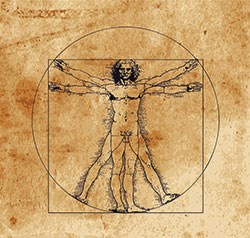EYFS Best Practice - All about… embodied learning
Dr Jennifer S Thom
Monday, November 27, 2017
Early years practitioners need to see learning – particularly in mathematics – not as abstract and ‘disembodied’ but as inherently concrete and ‘embodied’. Dr Jennifer S Thom explains why

Download the pdf
CURRENT THEORIES in cognitive science and mathematics education are challenging deep-seated assumptions about the nature of cognition, mathematics and mathematical activity. Such views reject the idea that mathematics is abstract and objective, and that acquiring mathematical knowledge requires the body only from the ‘neck up’. In contrast, knowledge is illuminated as inherently concrete, (em)bodied and live(d).
Such thinking raises important implications for early years pedagogy. By making the connections between mathematics and the bodily ways in which we learn, practitioners can enact practices that enable young children’s deeper and broader understanding of all things mathematical.
MATHS AND OUR BODIES
If we think about mathematics in a most basic way and how it evolves, we can see that mathematics and mathematical ways of knowing have everything to do with our human and cultural ways of being in the world.
Head to toe
The term digit, for example, means ‘numeral below ten’. It comes from the Latin word, digiti for ‘fingers or toes,’ corresponding to the ten digits on our hands and feet. Digit also refers to the ten symbols (0 to 9) that are used in the base ten numeral system and which we use to record, measure and quantify the world.

And how about the famous drawing, Vitruvian Man, by Leonardo da Vinci (1452-1519) (see right)? The drawing, named after first century BC Roman architect and engineer Vitruvius, features Vitruvius’ geometric work that identifies the ideal proportions of the human figure – proportions on which the classical orders of architecture are based.
From the circle around the man, we can see that the navel marks the centre of the outstretched human body, and
From the square around the man, we can see that the arm span and height of the human body are the same.
Nature, culture and maths
A more recent example that illustrates how interrelated mathematics, culture and humans as natural systems really are can be seen in the work of mathematician Benoit Mandelbrot.
Struck by the disconnect between nature and geometry, Mandelbrot remarked in his book The Fractal Geometry of Nature, ‘Clouds are not spheres, mountains are not cones, coastlines are not circles, and bark is not smooth, nor does lightning travel in a straight line.’
In practical ways, Mandelbrot’s mathematics has made all sorts of new technologies possible, including cell phone antennae, special effects in the film industry and increasing the amount of energy collected through solar panels.
Fractal geometry has also revealed new insights about nature—including us. Our lungs, our circulatory system and our brains, for example, resemble complex patterns similar to those also found in trees. The continuous branching structures in trees and us optimise function by maximising length, capacity and surface area.
Embedded and bodied
Mathematics as human activity and a growing body of knowledge has evolved over millennia, making it undeniably (em)bodied; in other words, culturally embedded and biologically bodied.
Cognitive linguist George Lakoff and cognitive scientist Raphael Núñez make this point clear when they say that the only mathematics we can know is the mathematics that our biological and cultural bodies allow us to know. As a discipline and a cultural practice then, mathematics enables us to understand, relate to and continually create the world in which we live.
Yet mathematics and its practices are often viewed as disembodied, absolute, objective and abstract. The contradiction necessitates closer consideration of early years practices and young children’s engagement with mathematics.
DISEMBODIED MATHS IN THE EARLY YEARS
Approaches to learning
Familiar to mathematics teaching and learning in the early years are approaches that focus on children’s connections to the real world. Here, everyday objects, pictures and verbal language are incorporated into ‘play-based’ and ‘hands-on’ situations that model mathematical concepts in order to develop young children’s understanding of the subject.
Three-dimensional geometric objects such as a sphere might be identified and described concretely as grapes in a lunchbox, pictorially as planet earth in a storybook or verbally as a ball on the playground. The inclusion of these real-world objects and language is to support children’s conceptual development and progression from informal, concrete and everyday examples to more formal, abstract and mathematical ones.
In turn, how children use these objects, words and actions provides educators with a window into children’s minds and allows them to assess what the children know or have learned in mathematics.
Such practices are considered to be pedagogically responsive. However, in particular ways, they perpetuate the image of mathematics and being mathematical as predetermined, mechanistic and ‘out-there’ or independent of us.
Assessing learning
If we assume that children’s play and activity are external representations of their inner cognitive schemas, then we view their acts as substitutions for something else — such as, an aspect of mathematical thinking.
This idea is not new to early years education. In fact, the concept is well established in psychology and played a critical role in the assessment and theory building about children’s spatial development by psychologists Jean Piaget and Bärbel Inhelder (1967).
A child’s ability or inability to copy two-dimensional shapes was presumed to coincide with their conceptualisation of those shapes. Inaccuracies not only revealed deficiencies in spatial awareness but also indicated whether the child’s cognitive development was at preoperational, concrete-operational or formal operational stage.
What is important to note here is that the children’s work was observed as re-presentative of their cognitive potential and mathematical understanding, and not viewed as their ‘bodying forth’ of mathematics and mathematical ways of knowing.
Concrete to abstract thinking
This view of mathematics as known objects can be seen in today’s (not so) new trends in education that predetermine, categorise and order concepts, and then prescribe teaching methods that treat maths learning as a series of paths or trajectories.
So, while these past and present-day approaches generally acknowledge the usefulness of hands-on and play-based activities, they tend to further entrench mathematics teaching and learning as a predictable developmental progression from the concrete to the abstract.
Consequently, early years mathematics remains limited by cognitive perspectives that simplify and separate mind from body while valuing fixed, abstract and mental operations.
These perspectives and the pedagogical practices they engender overlook, and in some cases completely ignore, the vital roles that the human body and cultural ways of knowing play in determining the mathematics we come to know, as well as what it means to be mathematical.
Given the (em)bodied nature of our counting system, classical architecture, today’s technologies and the distinctions we make of nature including our human anatomy, how did mathematics teaching and learning become so disembodied? Why is abstract mathematics privileged over more live(d) forms of knowledge? And, what are alternative ways of thinking that allow for young children’s (em)bodied mathematics and ways of being mathematical?
THE SEPARATION OF MIND AND BODY
To understand why mathematics teaching and learning became so disembodied, we must turn to the work of philosopher and mathematician René Descartes (1596-1650).
Today words like the Cartesian split, dichotomy or dualism are used to refer to the separation of mind and body. The origin of these terms, however, can be traced back even further to Ancient Greece.
According to Plato, ideas reigned supreme and were regarded as the highest reality. Ideal reality was intangible, fixed and abstract. Physical sensations and impressions of the material world were impure and imperfect imitations of perfect ideas.
Carrying this view of reality forward, philosopher and mathematician Descartes created a new philosophy of Rationalism. His famous cogito, ‘I think, therefore I am’, assumed that the higher eternal truths bestowed by God, such as certainty, mathematics and metaphysics, originated and existed outside of the body. Therefore, the only way to achieve these truths was through abstract and rational thought. Any knowledge related to the body was rejected and eradicated.
In this manner, Descartes ushered in the Age of Reason, separating ideal of the mind from material of the body. Almost 400 years later, rational disembodied thought continues as a privileged and unquestioned truth that trivialises sensory experience, underpins much of today’s Western beliefs and, arguably, influences mainstream pedagogical practices, including mathematics.
Consider the metaphors commonly used to describe knowledge: scaffold, build, acquire, absorb, process, transfer, give, share, store and access. The meanings evoked by these words characterise mind where knowledge, knowing, thought, thinking, concepts and understandings are totally disconnected from any material or cultural body. Mind and body have little or nothing to do with each other.
The body or more specifically and limiting, the brain, serves as only a vessel in which to hold knowledge and a channel through which to communicate mind.
REUNITING BODY AND MIND
Embodiment is most often associated with philosopher Maurice Merleau-Ponty (1908-1961). He challenged Descartes’ rationalist thinking by arguing that the body was the source of all knowing. He also rejected Descartes’ belief that sensory perception could not be trusted.
In contrast to thinking of the body as a container that held knowledge, or the world as external and inert, Merleau-Ponty asserted that our perceptions are essential for cognition. Our perceptions do not separate us from the world. Rather, they are precisely what connect us to it—for example, ourselves with other(s), inside with outside and knowing with doing. Each is a part of the other that shapes the world as the world shapes us. Hence, Merleau-Ponty did not consider actions to be re-presentative of ‘knowns’ but activity as knowing that emerges with the world.
For half a century in cognitive science and more than two decades in mathematics education, researchers have confronted taken-for-granted assumptions about perception, knowledge and knowing. Now the particular role that sensorimotor experience plays in creating and understanding both informal as well as formal mathematics concepts is increasingly recognised and articulated. Bodily concepts such as orientation (for example, left-handed and right-handed), appear in definitions of geometric concepts involving, ironically, the Cartesian coordinate system.
Further still, researchers have found that not only do children use their bodies in specific ways to make sense of seemingly abstract concepts, so do mathematicians. For example, two separate studies, one focused on young children and one involving mathematicians, revealed how both the children and the mathematicians conceptualised vectors as kinesthetic motion through time.
No rigid boundaries
It is also important to bear in mind that embodiment theories encompass much more than how bodily actions shape mathematics and mathematical understandings. In a fundamental way, embodiment is about embeddedness; that is, how there are no hard boundaries that separate bodies of individuals, groups, cultures and the world. All are nested within one another and knowledge and knowing are distributed across them. Therefore, as educators, we may focus on the mathematical understanding of one child, however, because of the distributed nature of cognition, it is also possible to broaden our focus so that we may attend to the collective understandings of a pair of children, a group of children with their teacher or an entire culture or cultures.
WHAT ‘EMBODIED LEARNING’ MEANS FOR EARLY YEARS PRACTICE
Three critical areas of early years mathematics pedagogy that are informed by (em)bodied theories are:
1. What mathematics is and what it means to be mathematical
Mathematics has the potential to relate children to rather than separate them from the world and mathematics itself.
Ideas and conceptualisations emerge and evolve as children experience and perceive connections in their everyday world. Thus, the curved surface of a ball is not so much a property of the ball as it is an event that happens as a child’s hand moves across the outside of the object.
(In)formal mathematics and thinking involves the entire body of the child, not just from their neck up. Consider the potential ways that a child’s walking along the perimeter of a playground engages their senses and develops their awareness and knowledge of its ‘squareness’—for example, its four straight sides of equal length and four right-angled corners.
(In)formal mathematics and thinking, while necessarily bodily, also depend on children’s culturally specific and taken-for-granted ways of practising mathematics. What kinds of number patterns are possible when the fingers and thumbs of the hand(s) are used to count?
Observation and assessment of conceptual understanding focus on children’s attention, awareness and meaning(s) that they attach to the particular mathematics with which they engage. Thus, children’s ‘failure’ to exhibit expected mathematics is not considered to be indicative of deficient or a lack of understanding.
Sophisticated understanding requires more than purely mental abstract thinking. It involves observing how children make sense and use mathematics across physical, imagined, spatial, numerical, quantitative, particular and general contexts.
Mathematics and being mathematical are children’s processes and products of visualising, imagining, gesturing, building, drawing, vocalising, talking, touching and moving.
2. The emergent nature of mathematics and ways of knowing
Being ‘in the moment’ as well as ‘moment to moment’ enables children and educators to respond to everyday situations that involve number, quantity, space and/or shape as these arise.
Ideas and meanings need to be accessible to children. In addition to oral language, encouraging and helping children to use their bodies in specific ways to sense and make new sense of mathematics creates opportunities to further their understanding. Compare how everyday materials, gestures, drawings, movement, touch and sound provoke similar and different ideas or meanings as well as why these activities are necessary for rich mathematics and ways of knowing.
Exploring materials and environments in new ways make the ‘familiar’ strange and curious. For example, what might ‘3’ sound like as a knock on the door? How else can we knock on the door three times? How is each knock the same and different from one another? Doing so invites children not only to connect their previous understandings but to also re-examine them to enable new thinking and mathematics to emerge.
Mathematics does not exist 'in' materials and contexts. As such, practitioners should avoid teaching that ‘tells’ or asks children to seek ‘certain truths’. Rather, posing questions like ‘what if…?’ and ‘what if… not…?’ invite children to actively wonder about and investigate mathematics as ‘probable truths’.
Exploring with children what mathematics is in its ‘whatness’ and ‘thatness’ (for example, what is it about the soup tin that allows it to roll, stack and slide?) rather than simply answering questions of ‘what is it?’ promotes the need for multiple and different meanings of a given concept, making mathematics more than a matter of naming and reciting ‘answers’.
3. The dynamics of mathematical ideas
Concepts of number, quantity, space and/or shape are not only dynamic but also abundant and diverse. Consider how a trip to the grocery store enables children to make sense of mathematical ideas in many different ways. For example, how does the context provide opportunities for children to experience number as a set of objects, a line, a rectangle or a pyramid?
Observing and assessing the dynamic nature of mathematical ideas requires not only listening to what children say but also attending to the other audible, silent, visible, physical and material forms that their mathematics and thinking take. What ideas and understandings are bodied forth by the gestures, sounds, building, drawing or movement of children?
Mathematics must be playful! Mathematical ideas and ways of knowing need to ‘mingle with’ and ‘play off’ one another as children engage in building, creating, talking, moving, singing, exploring and raising questions.
Helping children to become aware of and to reconsider ideas and ways of thinking that go unnoticed or are quickly dismissed as irrelevant can play a critical role in deepening their understanding.
Paying attention to how concepts and meanings are taken up by another child, an educator or the entire group: Which ideas and meanings help (or fail) to advance children’s thinking? How are the ideas and meanings adopted, abandoned, integrated or complemented in new ways by the children as they develop some particular mathematics?
CONCLUDING THOUGHTS
Children’s (em)bodiment of mathematics ‘is not a “noise” concealing an abstract configuration in its true essence. The concrete is not a step toward something else: it is both where we are and how we get to where we will be.’ (Varela, 1999, p7)
In a generative manner, the embedded and bodied nature of mathematics offers much for educators’ consideration regarding pedagogical practices in early years mathematics.
Dr Jennifer S Thom is associate professor, mathematics education and curriculum studies, University of Victoria, Canada. Her article ‘All about…spatial awareness’ will be published in Nursery World on 8 January 2018
Reference
Piaget, J & Inhelder, B (1967). The child’s conception of space. London: Routledge and Kegan Paul.
Varela, FJ (1999). Ethical know-how: Action, wisdom, and cognition. Stanford, CA: Stanford University Press








